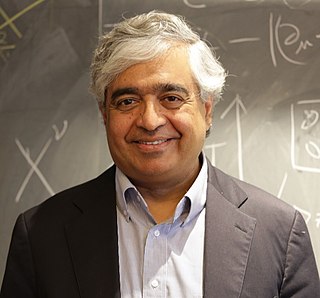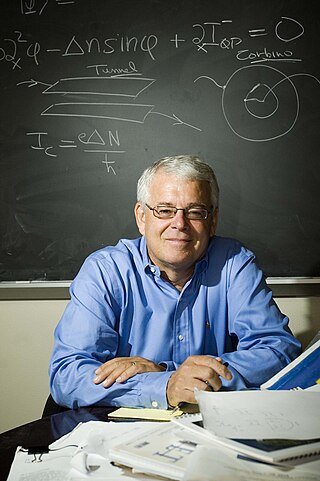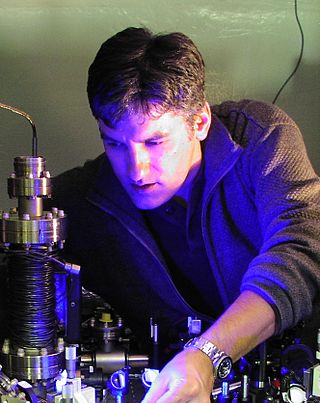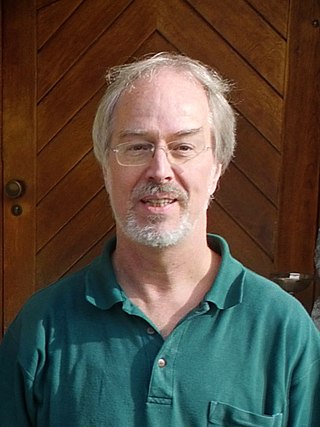Related Research Articles

In condensed matter physics, Hofstadter's butterfly is a graph of the spectral properties of non-interacting two-dimensional electrons in a perpendicular magnetic field in a lattice. The fractal, self-similar nature of the spectrum was discovered in the 1976 Ph.D. work of Douglas Hofstadter and is one of the early examples of modern scientific data visualization. The name reflects the fact that, as Hofstadter wrote, "the large gaps [in the graph] form a very striking pattern somewhat resembling a butterfly."

The Schwinger effect is a predicted physical phenomenon whereby matter is created by a strong electric field. It is also referred to as the Sauter–Schwinger effect, Schwinger mechanism, or Schwinger pair production. It is a prediction of quantum electrodynamics (QED) in which electron–positron pairs are spontaneously created in the presence of an electric field, thereby causing the decay of the electric field. The effect was originally proposed by Fritz Sauter in 1931 and further important work was carried out by Werner Heisenberg and Hans Heinrich Euler in 1936, though it was not until 1951 that Julian Schwinger gave a complete theoretical description.
Pomeranchuk cooling is the phenomenon in which liquid helium-3 will cool if it is compressed isentropically when it is below 0.3 K. This occurs because helium-3 has the unusual property that its solid state can have a higher entropy than its liquid state. The effect was first observed by Yuri Anufriev in 1965. This can be used to construct a cryogenic cooler.

Subir Sachdev is Herchel Smith Professor of Physics at Harvard University specializing in condensed matter. He was elected to the U.S. National Academy of Sciences in 2014, received the Lars Onsager Prize from the American Physical Society and the Dirac Medal from the ICTP in 2018, and was elected Foreign Member of the Royal Society ForMemRS in 2023. He was a co-editor of the Annual Review of Condensed Matter Physics 2017–2019, and is Editor-in-Chief of Reports on Progress in Physics 2022-.
Philippe Guyot-Sionnest is a professor at the University of Chicago appointed jointly in the departments of physics and chemistry. He works in the field of colloidal semiconductors and metal nanocrystals.
Bilayer graphene is a material consisting of two layers of graphene. One of the first reports of bilayer graphene was in the seminal 2004 Science paper by Geim and colleagues, in which they described devices "which contained just one, two, or three atomic layers"

Allan H. MacDonald is a theoretical condensed matter physicist and the Sid W. Richardson Foundation Regents Chair Professor of Physics at The University of Texas at Austin.

Tilman Esslinger is a German experimental physicist. He is Professor at ETH Zurich, Switzerland, and works in the field of ultracold quantum gases and optical lattices.

Christopher Roy Monroe is an American physicist and engineer in the areas of atomic, molecular, and optical physics and quantum information science, especially quantum computing. He directs one of the leading research and development efforts in ion trap quantum computing. Monroe is the Gilhuly Family Presidential Distinguished Professor of Electrical and Computer Engineering and Physics at Duke University and is College Park Professor of Physics at the University of Maryland and Fellow of the Joint Quantum Institute and Joint Center for Quantum Computer Science. He is also co-founder of IonQ, Inc.
Bernhard Keimer is a German physicist and Director at the Max Planck Institute for Solid State Research. His research group uses spectroscopic methods to explore quantum many-body phenomena in correlated-electron materials and metal-oxide heterostructures.
Jochen Mannhart is a German physicist.

Gerhard Rempe is a German physicist, Director at the Max Planck Institute of Quantum Optics and Honorary Professor at the Technical University of Munich. He has performed pioneering experiments in atomic and molecular physics, quantum optics and quantum information processing.

Michel Devoret is a French physicist and F. W. Beinecke Professor of Applied Physics at Yale University. He also holds a position as the Director of the Applied Physics Nanofabrication Lab at Yale. He is known for his pioneering work on macroscopic quantum tunneling, and the single-electron pump as well as in groundbreaking contributions to initiating the fields of circuit quantum electrodynamics and quantronics.
Eva Yocheved Andrei is an American condensed matter physicist, a Distinguished Professor, and a Board of Governors Professor at Rutgers University. Her research focuses on emergent properties of matter arising from the collective behavior of many particles, especially low-dimensional phenomena under low temperatures and high magnetic fields.

Alessandra Lanzara is an Italian-American physicist and the distinguished Charles Kittel Professor of physics at the University of California, Berkeley since 2002, where she leads an experimental materials physics group. She is the founding director of Center for Sustainable Innovation at UCB and the co-founder of Quantum Advanced Detection (QUAD) LLC.

Twistronics is the study of how the angle between layers of two-dimensional materials can change their electrical properties. Materials such as bilayer graphene have been shown to have vastly different electronic behavior, ranging from non-conductive to superconductive, that depends sensitively on the angle between the layers. The term was first introduced by the research group of Efthimios Kaxiras at Harvard University in their theoretical treatment of graphene superlattices.
Rafi Bistritzer is an Israeli physicist, and manager of an algorithms group at Applied Materials. He is the winner of the 2020 Wolf Prize in Physics, together with Pablo Jarillo-Herrero and Allan MacDonald, for “pioneering theoretical and experimental work on twisted bilayer graphene.”
Bogdan Andrei Bernevig is a Romanian Quantum Condensed Matter Professor of Physics at Princeton University and the recipient of the John Simon Guggenheim Fellowship in 2017.
The term heterostrain was proposed in 2018 in the context of materials science to simplify the designation of possible strain situations in van der Waals heterostructures where two two-dimensional materials are stacked on top of each other. These layers can experience the same deformation (homostrain) or different deformations (heterostrain). In addition to twist, heterostrain can have important consequences on the electronic and optical properties of the resulting structure. As such, the control of heterostrain is emerging as a sub-field of straintronics in which the properties of 2D materials are controlled by strain. Recent works have reported a deterministic control of heterostrain by sample processing or with the tip of an AFM of particular interest in twisted heterostructures. Heterostrain alone has also been identified as a parameter to tune the electronic properties of van der Waals structures as for example in twisted graphene layers with biaxial heterostrain.
In physics, Edge states are the topologically protected electronic states that exist at the boundary of the material and cannot be removed without breaking the system's symmetry.
References
- ↑ "MIT Physics faculty" . Retrieved October 18, 2020.
- ↑ Cuesta, Irma (March 30, 2018). "¿Por qué el grafeno cambiará el mundo?" (in Spanish). Las provincias. Retrieved June 18, 2020.
- ↑ "Jarillo, en la UPV" (in Spanish). Universidad Politécnica de Valencia . Retrieved June 18, 2020.
- ↑ Bistritzer, Rafi; MacDonald, Allan H. (July 26, 2011). "Moiré bands in twisted double-layer graphene". Proceedings of the National Academy of Sciences . 108 (30): 12233–12237. arXiv: 1009.4203 . Bibcode:2011PNAS..10812233B. doi: 10.1073/pnas.1108174108 . PMC 3145708 . PMID 21730173.
- ↑ Sacristán, Enrique (March 5, 2018). Agencia SINC (ed.). "Un giro 'mágico' dota de superconductividad al grafeno" (in Spanish). Retrieved June 18, 2020.
- ↑ "New twist on graphene gets materials scientists hot under the collar". Chemistry World . March 19, 2019. Retrieved September 29, 2020.
- ↑ Pablo Jarillo-Herrero: Magic Angle Graphene: a New Platform for Strongly Correlated Physics. In: Department of Physics – MIT, September 26, 2019.
- ↑ "With a Simple Twist, a 'Magic' Material Is Now the Big Thing in Physics". Quanta Magazine . April 30, 2019. Retrieved September 29, 2020.
- ↑ "New twist on graphene gets materials scientists hot under the collar". New York Times . October 30, 2019. Retrieved September 29, 2020.
- ↑ "National Academy of Sciences Elects Members and International Members". News from the National Academy of Sciences. May 3, 2022.
- ↑ Miller, Sandi (May 12, 2022). "Three from MIT elected to the National Academy of Sciences for 2022". MIT News. Massachusetts Institute of Technology.
- ↑ "Pablo Jarillo-Herrero recibe premio consejo social UV".
- ↑ "Richard E. Prange Prize and Lectureship".
- ↑ "Prize laureates".
- ↑ "Max Planck-Humboldt Research Award for new quantum material".
- ↑ "HOME | NIMS Award".
- ↑ "2021 NAS Awards Recipients Announced".
- ↑ "Pablo Jarillo-Herrero wins 2020 Spanish Royal Physics Society Medal". MIT News | Massachusetts Institute of Technology. October 2020.
- ↑ Wolf Prize 2020
- ↑ APS: Laudatio